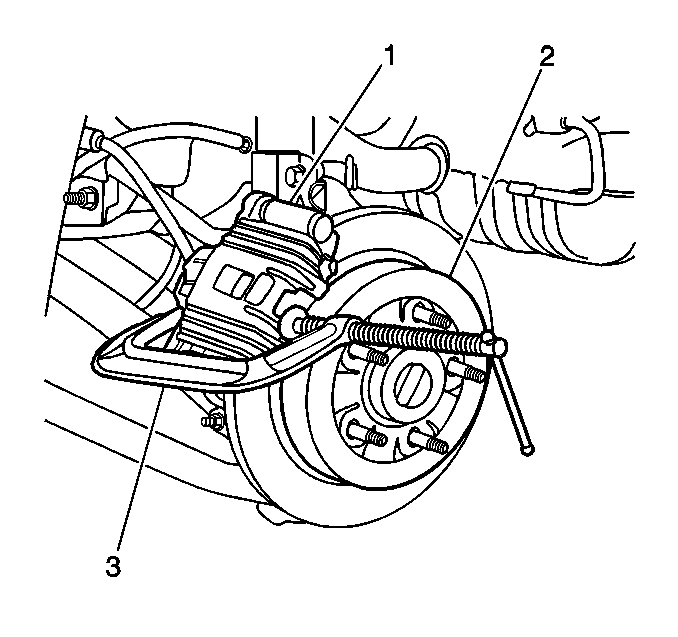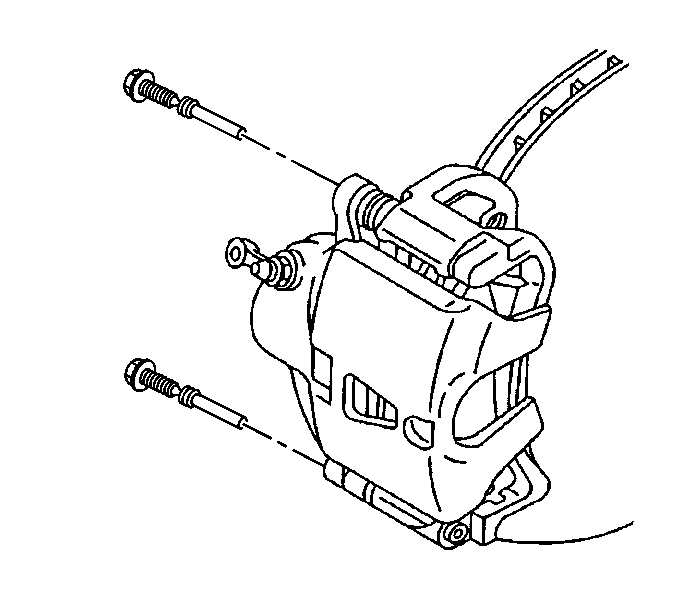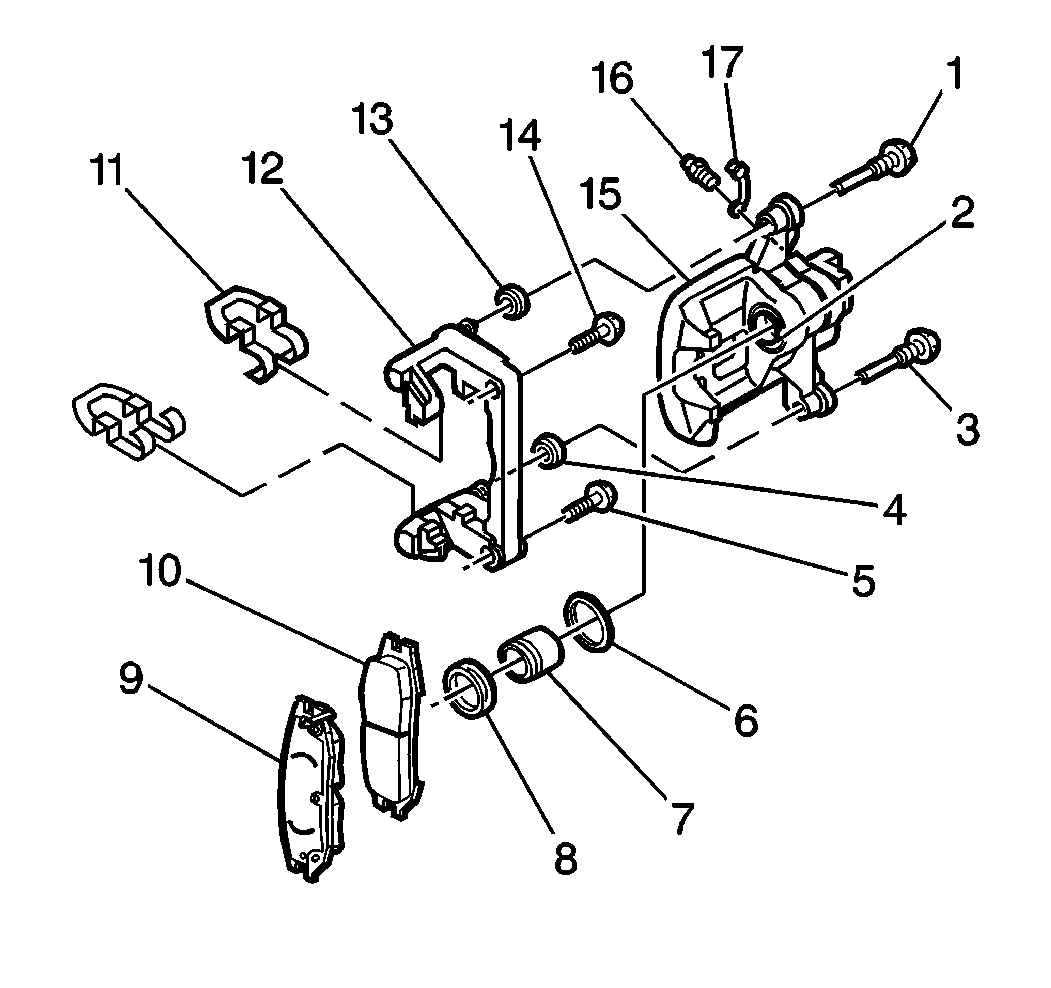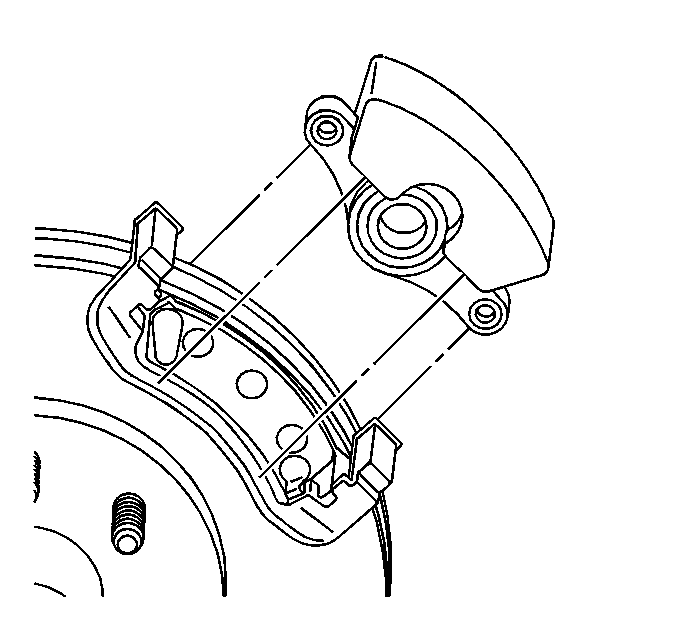Removal Procedure
- Remove 2/3 of the brake fluid from the master cylinder.
- Raise and support the vehicle. Refer to
Lifting and Jacking the Vehicle
.
- Mark the relationship of the wheel to the hub and bearing.
- Remove the tire and wheel assembly. Refer to
Tire and Wheel Removal and Installation
in Tires
and Wheels.
Reinstall 2 wheel nuts in order to retain the rotor.

- Push the piston into the
caliper bore in order to provide clearance between the linings and the rotor.
Complete the following steps:
| 5.1. | Install a large C-clamp (3) over the top of the caliper housing (1)
and against the back of the outboard pad. |
| 5.2. | Slowly tighten the C-clamp until the piston is pushed into the
caliper bore enough to slide the caliper (1) off the rotor. Do not
overtighten the C-clamp. |

- Remove the brake hose
bolt and the inlet fitting.
- Remove and discard the sealing washers (2).
- Plug the openings in the caliper housing and the hose fitting
in order to prevent brake fluid loss and contamination.

- Remove the caliper bolts.

- Remove the caliper housing (15)
from the caliper bracket (12).
- Inspect the piston boot (8) for the following conditions:
- Inspect the caliper bracket boots (13,4) for the following
conditions:
| • | Replace the caliper bracket boots if damage exists. |
- Inspect the caliper bolts (1, 3) for corrosion or damage.
If corrosion is found, use new parts when installing the caliper. Do not attempt
to polish away corrosion.
Installation Procedure

- Install the caliper to
the caliper bracket.

- Lubricate the caliper bolts with GM P/N 18010908
silicone grease or equivalent. Do not lubricate the threads.
- Lubricate the rubber boots in the caliper bracket with GM P/N 18010908
silicone grease or equivalent.
Notice: Use the correct fastener in the correct location. Replacement fasteners
must be the correct part number for that application. Fasteners requiring
replacement or fasteners requiring the use of thread locking compound or sealant
are identified in the service procedure. Do not use paints, lubricants, or
corrosion inhibitors on fasteners or fastener joint surfaces unless specified.
These coatings affect fastener torque and joint clamping force and may damage
the fastener. Use the correct tightening sequence and specifications when
installing fasteners in order to avoid damage to parts and systems.
- Install the caliper bolts. Ensure that
the boot is securely in the groove of the caliper bolt.
Tighten
Tighten the caliper bolts to 110 N·m(81 lb ft).

- Install new sealing washers (2)
and the bolt to the brake hose inlet fitting.
- Install the brake hose bolt and fitting to the caliper.
Tighten
Tighten the brake hose bolt to 50 N·m(37 lb ft).
- Remove the wheel nuts securing the rotor to the hub.
- Install the tire and wheel assembly. Refer to
Tire and Wheel Removal and Installation
in Tires
and Wheels.
Align the index marks on the wheel and the hub.
- Lower the vehicle.
- Fill the master cylinder to the proper level with clean brake
fluid. Refer to
Master Cylinder Reservoir Filling
in Hydraulic Brakes.
- Bleed the entire brake system. Refer to
Hydraulic Brake System Bleeding
in Hydraulic Brakes.
- Apply approximately 778 N (175 lb) of force to the
brake pedal 3 times in order to seat the pads against the rotor.
- Inspect the hydraulic brake system for brake fluid leaks. Refer
to
Brake Fluid Leak
in Hydraulic
Brakes.







